Clinical Analysis: Detailed Assessment of George's Health Case Study
VerifiedAdded on 2022/09/18
|7
|1814
|227
Case Study
AI Summary
This case study focuses on the clinical analysis of George, a 45-year-old male with a family history of heart-related conditions. The analysis examines George's health history, including his father's death from a heart attack and his mother's stroke, highlighting the increased risk factors. A focused assessment is conducted, including ECG analysis, which revealed an ST elevation indicating a possible acute anterior myocardial infarction, and blood pathology tests, which indicated elevated cholesterol and triglyceride levels, and moderately raised troponin levels. The study recommends further interventions such as IVC insertion, aspirin, and GTN administration, along with lifestyle adjustments like reducing stress, increasing exercise, and adopting a healthy diet to manage his hypertension and potential heart attack risks. The analysis emphasizes the importance of understanding family history and proactively managing other modifiable risk factors to prevent heart disease.
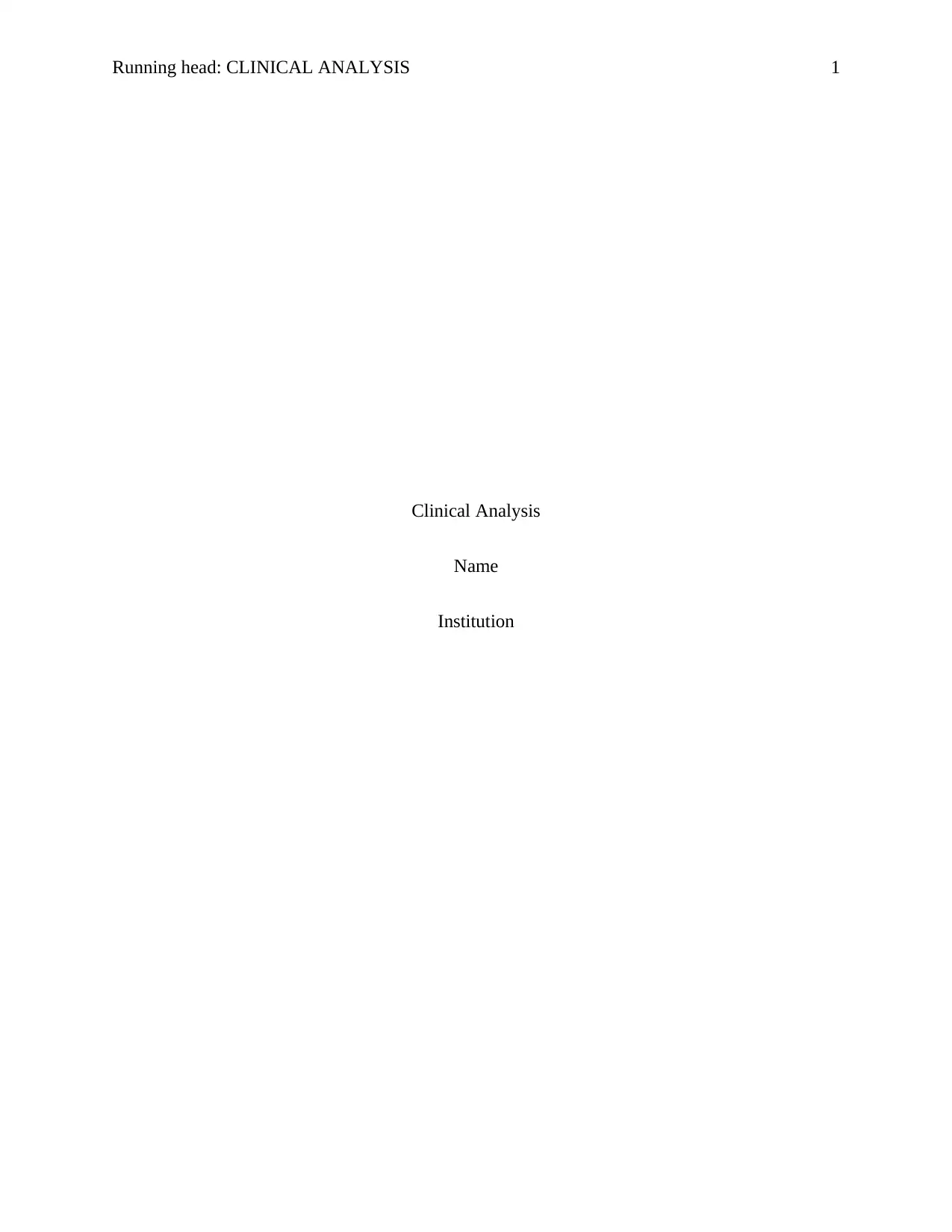
Running head: CLINICAL ANALYSIS 1
Clinical Analysis
Name
Institution
Clinical Analysis
Name
Institution
Paraphrase This Document
Need a fresh take? Get an instant paraphrase of this document with our AI Paraphraser
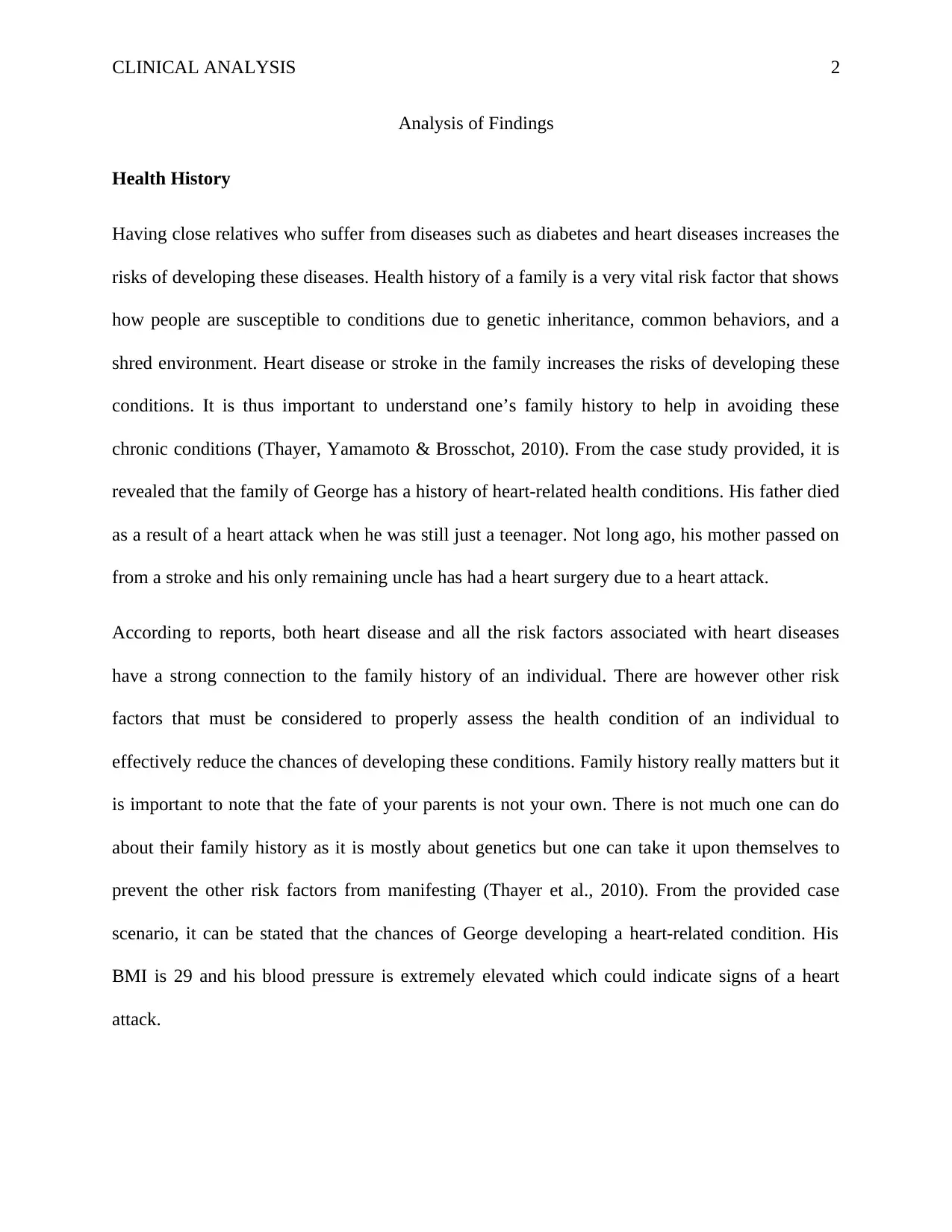
CLINICAL ANALYSIS 2
Analysis of Findings
Health History
Having close relatives who suffer from diseases such as diabetes and heart diseases increases the
risks of developing these diseases. Health history of a family is a very vital risk factor that shows
how people are susceptible to conditions due to genetic inheritance, common behaviors, and a
shred environment. Heart disease or stroke in the family increases the risks of developing these
conditions. It is thus important to understand one’s family history to help in avoiding these
chronic conditions (Thayer, Yamamoto & Brosschot, 2010). From the case study provided, it is
revealed that the family of George has a history of heart-related health conditions. His father died
as a result of a heart attack when he was still just a teenager. Not long ago, his mother passed on
from a stroke and his only remaining uncle has had a heart surgery due to a heart attack.
According to reports, both heart disease and all the risk factors associated with heart diseases
have a strong connection to the family history of an individual. There are however other risk
factors that must be considered to properly assess the health condition of an individual to
effectively reduce the chances of developing these conditions. Family history really matters but it
is important to note that the fate of your parents is not your own. There is not much one can do
about their family history as it is mostly about genetics but one can take it upon themselves to
prevent the other risk factors from manifesting (Thayer et al., 2010). From the provided case
scenario, it can be stated that the chances of George developing a heart-related condition. His
BMI is 29 and his blood pressure is extremely elevated which could indicate signs of a heart
attack.
Analysis of Findings
Health History
Having close relatives who suffer from diseases such as diabetes and heart diseases increases the
risks of developing these diseases. Health history of a family is a very vital risk factor that shows
how people are susceptible to conditions due to genetic inheritance, common behaviors, and a
shred environment. Heart disease or stroke in the family increases the risks of developing these
conditions. It is thus important to understand one’s family history to help in avoiding these
chronic conditions (Thayer, Yamamoto & Brosschot, 2010). From the case study provided, it is
revealed that the family of George has a history of heart-related health conditions. His father died
as a result of a heart attack when he was still just a teenager. Not long ago, his mother passed on
from a stroke and his only remaining uncle has had a heart surgery due to a heart attack.
According to reports, both heart disease and all the risk factors associated with heart diseases
have a strong connection to the family history of an individual. There are however other risk
factors that must be considered to properly assess the health condition of an individual to
effectively reduce the chances of developing these conditions. Family history really matters but it
is important to note that the fate of your parents is not your own. There is not much one can do
about their family history as it is mostly about genetics but one can take it upon themselves to
prevent the other risk factors from manifesting (Thayer et al., 2010). From the provided case
scenario, it can be stated that the chances of George developing a heart-related condition. His
BMI is 29 and his blood pressure is extremely elevated which could indicate signs of a heart
attack.
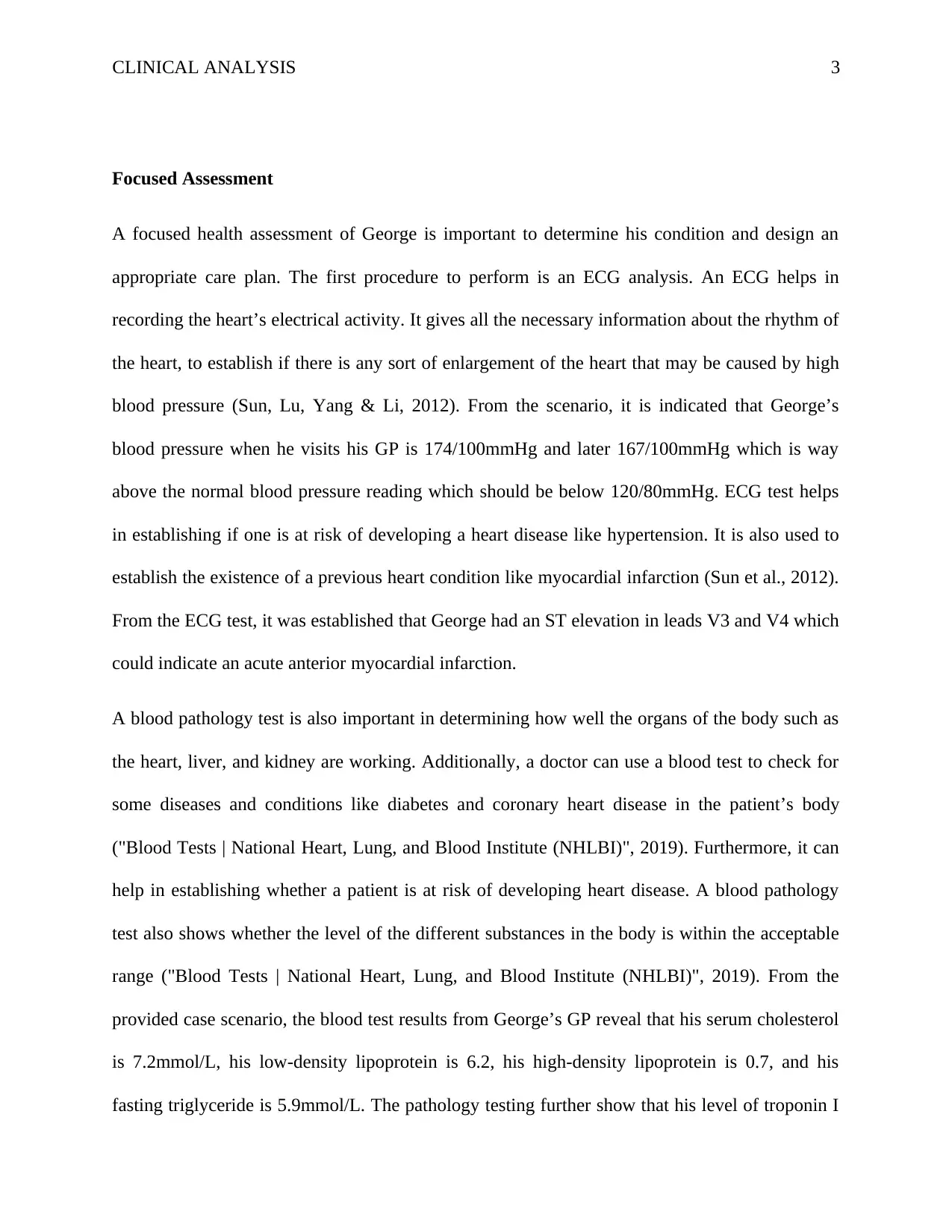
CLINICAL ANALYSIS 3
Focused Assessment
A focused health assessment of George is important to determine his condition and design an
appropriate care plan. The first procedure to perform is an ECG analysis. An ECG helps in
recording the heart’s electrical activity. It gives all the necessary information about the rhythm of
the heart, to establish if there is any sort of enlargement of the heart that may be caused by high
blood pressure (Sun, Lu, Yang & Li, 2012). From the scenario, it is indicated that George’s
blood pressure when he visits his GP is 174/100mmHg and later 167/100mmHg which is way
above the normal blood pressure reading which should be below 120/80mmHg. ECG test helps
in establishing if one is at risk of developing a heart disease like hypertension. It is also used to
establish the existence of a previous heart condition like myocardial infarction (Sun et al., 2012).
From the ECG test, it was established that George had an ST elevation in leads V3 and V4 which
could indicate an acute anterior myocardial infarction.
A blood pathology test is also important in determining how well the organs of the body such as
the heart, liver, and kidney are working. Additionally, a doctor can use a blood test to check for
some diseases and conditions like diabetes and coronary heart disease in the patient’s body
("Blood Tests | National Heart, Lung, and Blood Institute (NHLBI)", 2019). Furthermore, it can
help in establishing whether a patient is at risk of developing heart disease. A blood pathology
test also shows whether the level of the different substances in the body is within the acceptable
range ("Blood Tests | National Heart, Lung, and Blood Institute (NHLBI)", 2019). From the
provided case scenario, the blood test results from George’s GP reveal that his serum cholesterol
is 7.2mmol/L, his low-density lipoprotein is 6.2, his high-density lipoprotein is 0.7, and his
fasting triglyceride is 5.9mmol/L. The pathology testing further show that his level of troponin I
Focused Assessment
A focused health assessment of George is important to determine his condition and design an
appropriate care plan. The first procedure to perform is an ECG analysis. An ECG helps in
recording the heart’s electrical activity. It gives all the necessary information about the rhythm of
the heart, to establish if there is any sort of enlargement of the heart that may be caused by high
blood pressure (Sun, Lu, Yang & Li, 2012). From the scenario, it is indicated that George’s
blood pressure when he visits his GP is 174/100mmHg and later 167/100mmHg which is way
above the normal blood pressure reading which should be below 120/80mmHg. ECG test helps
in establishing if one is at risk of developing a heart disease like hypertension. It is also used to
establish the existence of a previous heart condition like myocardial infarction (Sun et al., 2012).
From the ECG test, it was established that George had an ST elevation in leads V3 and V4 which
could indicate an acute anterior myocardial infarction.
A blood pathology test is also important in determining how well the organs of the body such as
the heart, liver, and kidney are working. Additionally, a doctor can use a blood test to check for
some diseases and conditions like diabetes and coronary heart disease in the patient’s body
("Blood Tests | National Heart, Lung, and Blood Institute (NHLBI)", 2019). Furthermore, it can
help in establishing whether a patient is at risk of developing heart disease. A blood pathology
test also shows whether the level of the different substances in the body is within the acceptable
range ("Blood Tests | National Heart, Lung, and Blood Institute (NHLBI)", 2019). From the
provided case scenario, the blood test results from George’s GP reveal that his serum cholesterol
is 7.2mmol/L, his low-density lipoprotein is 6.2, his high-density lipoprotein is 0.7, and his
fasting triglyceride is 5.9mmol/L. The pathology testing further show that his level of troponin I
⊘ This is a preview!⊘
Do you want full access?
Subscribe today to unlock all pages.

Trusted by 1+ million students worldwide
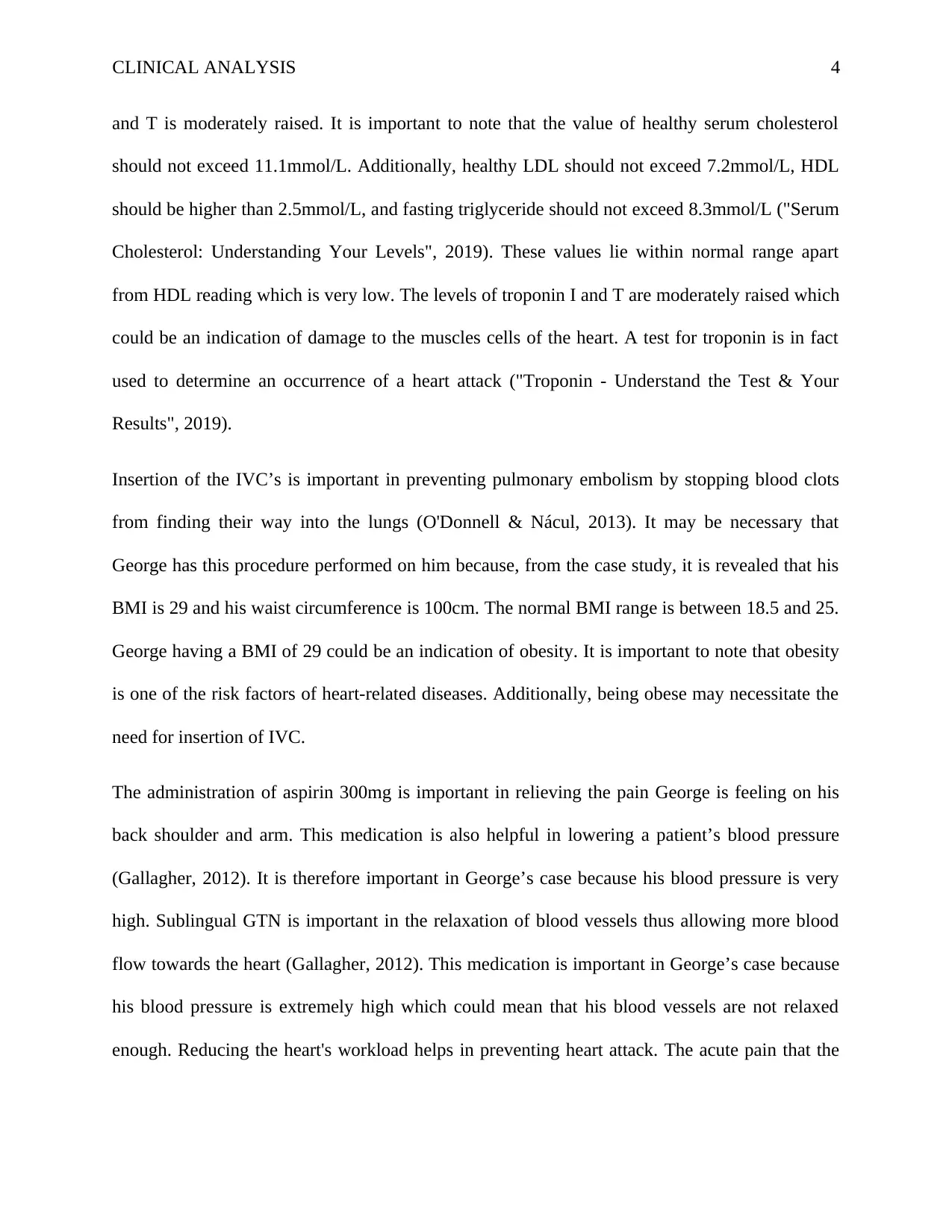
CLINICAL ANALYSIS 4
and T is moderately raised. It is important to note that the value of healthy serum cholesterol
should not exceed 11.1mmol/L. Additionally, healthy LDL should not exceed 7.2mmol/L, HDL
should be higher than 2.5mmol/L, and fasting triglyceride should not exceed 8.3mmol/L ("Serum
Cholesterol: Understanding Your Levels", 2019). These values lie within normal range apart
from HDL reading which is very low. The levels of troponin I and T are moderately raised which
could be an indication of damage to the muscles cells of the heart. A test for troponin is in fact
used to determine an occurrence of a heart attack ("Troponin - Understand the Test & Your
Results", 2019).
Insertion of the IVC’s is important in preventing pulmonary embolism by stopping blood clots
from finding their way into the lungs (O'Donnell & Nácul, 2013). It may be necessary that
George has this procedure performed on him because, from the case study, it is revealed that his
BMI is 29 and his waist circumference is 100cm. The normal BMI range is between 18.5 and 25.
George having a BMI of 29 could be an indication of obesity. It is important to note that obesity
is one of the risk factors of heart-related diseases. Additionally, being obese may necessitate the
need for insertion of IVC.
The administration of aspirin 300mg is important in relieving the pain George is feeling on his
back shoulder and arm. This medication is also helpful in lowering a patient’s blood pressure
(Gallagher, 2012). It is therefore important in George’s case because his blood pressure is very
high. Sublingual GTN is important in the relaxation of blood vessels thus allowing more blood
flow towards the heart (Gallagher, 2012). This medication is important in George’s case because
his blood pressure is extremely high which could mean that his blood vessels are not relaxed
enough. Reducing the heart's workload helps in preventing heart attack. The acute pain that the
and T is moderately raised. It is important to note that the value of healthy serum cholesterol
should not exceed 11.1mmol/L. Additionally, healthy LDL should not exceed 7.2mmol/L, HDL
should be higher than 2.5mmol/L, and fasting triglyceride should not exceed 8.3mmol/L ("Serum
Cholesterol: Understanding Your Levels", 2019). These values lie within normal range apart
from HDL reading which is very low. The levels of troponin I and T are moderately raised which
could be an indication of damage to the muscles cells of the heart. A test for troponin is in fact
used to determine an occurrence of a heart attack ("Troponin - Understand the Test & Your
Results", 2019).
Insertion of the IVC’s is important in preventing pulmonary embolism by stopping blood clots
from finding their way into the lungs (O'Donnell & Nácul, 2013). It may be necessary that
George has this procedure performed on him because, from the case study, it is revealed that his
BMI is 29 and his waist circumference is 100cm. The normal BMI range is between 18.5 and 25.
George having a BMI of 29 could be an indication of obesity. It is important to note that obesity
is one of the risk factors of heart-related diseases. Additionally, being obese may necessitate the
need for insertion of IVC.
The administration of aspirin 300mg is important in relieving the pain George is feeling on his
back shoulder and arm. This medication is also helpful in lowering a patient’s blood pressure
(Gallagher, 2012). It is therefore important in George’s case because his blood pressure is very
high. Sublingual GTN is important in the relaxation of blood vessels thus allowing more blood
flow towards the heart (Gallagher, 2012). This medication is important in George’s case because
his blood pressure is extremely high which could mean that his blood vessels are not relaxed
enough. Reducing the heart's workload helps in preventing heart attack. The acute pain that the
Paraphrase This Document
Need a fresh take? Get an instant paraphrase of this document with our AI Paraphraser
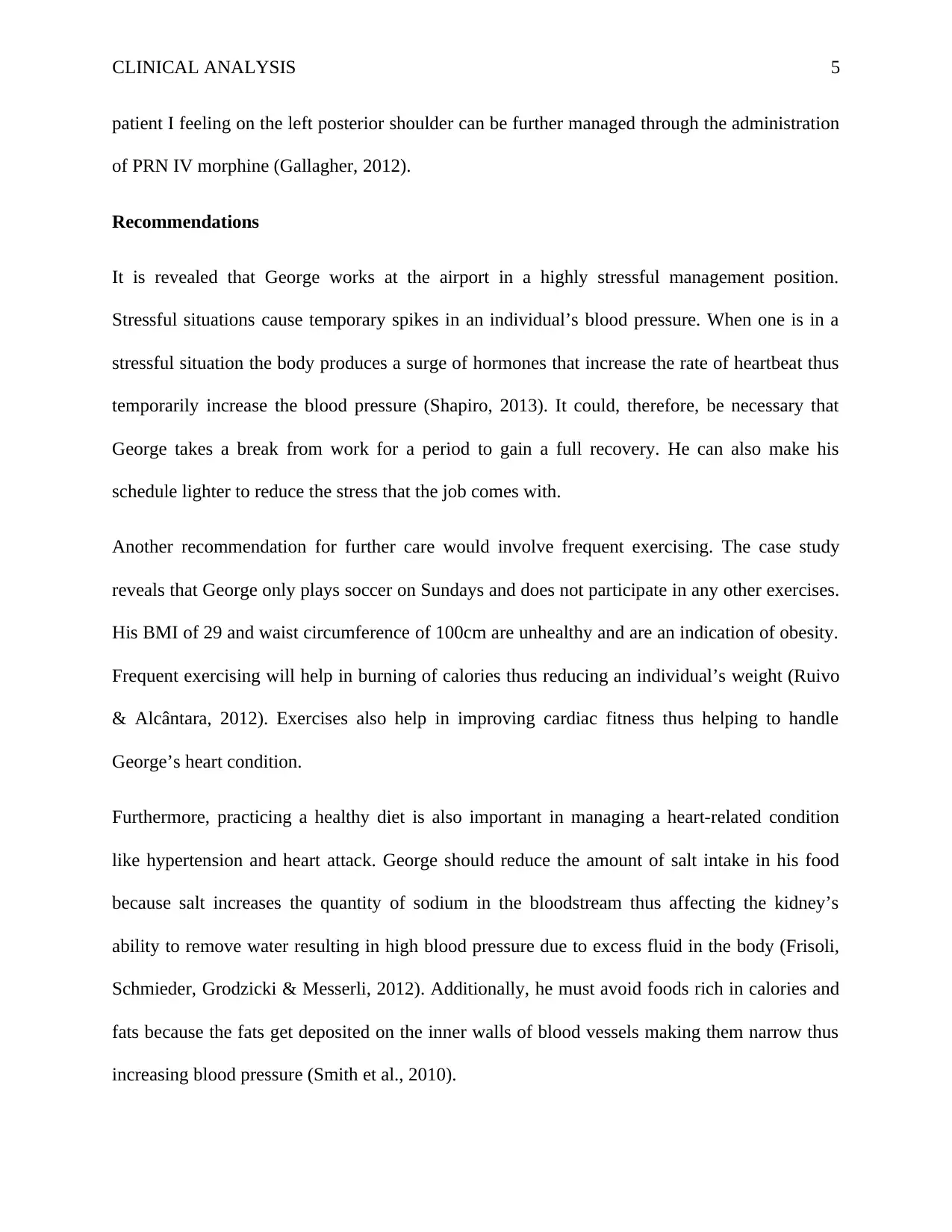
CLINICAL ANALYSIS 5
patient I feeling on the left posterior shoulder can be further managed through the administration
of PRN IV morphine (Gallagher, 2012).
Recommendations
It is revealed that George works at the airport in a highly stressful management position.
Stressful situations cause temporary spikes in an individual’s blood pressure. When one is in a
stressful situation the body produces a surge of hormones that increase the rate of heartbeat thus
temporarily increase the blood pressure (Shapiro, 2013). It could, therefore, be necessary that
George takes a break from work for a period to gain a full recovery. He can also make his
schedule lighter to reduce the stress that the job comes with.
Another recommendation for further care would involve frequent exercising. The case study
reveals that George only plays soccer on Sundays and does not participate in any other exercises.
His BMI of 29 and waist circumference of 100cm are unhealthy and are an indication of obesity.
Frequent exercising will help in burning of calories thus reducing an individual’s weight (Ruivo
& Alcântara, 2012). Exercises also help in improving cardiac fitness thus helping to handle
George’s heart condition.
Furthermore, practicing a healthy diet is also important in managing a heart-related condition
like hypertension and heart attack. George should reduce the amount of salt intake in his food
because salt increases the quantity of sodium in the bloodstream thus affecting the kidney’s
ability to remove water resulting in high blood pressure due to excess fluid in the body (Frisoli,
Schmieder, Grodzicki & Messerli, 2012). Additionally, he must avoid foods rich in calories and
fats because the fats get deposited on the inner walls of blood vessels making them narrow thus
increasing blood pressure (Smith et al., 2010).
patient I feeling on the left posterior shoulder can be further managed through the administration
of PRN IV morphine (Gallagher, 2012).
Recommendations
It is revealed that George works at the airport in a highly stressful management position.
Stressful situations cause temporary spikes in an individual’s blood pressure. When one is in a
stressful situation the body produces a surge of hormones that increase the rate of heartbeat thus
temporarily increase the blood pressure (Shapiro, 2013). It could, therefore, be necessary that
George takes a break from work for a period to gain a full recovery. He can also make his
schedule lighter to reduce the stress that the job comes with.
Another recommendation for further care would involve frequent exercising. The case study
reveals that George only plays soccer on Sundays and does not participate in any other exercises.
His BMI of 29 and waist circumference of 100cm are unhealthy and are an indication of obesity.
Frequent exercising will help in burning of calories thus reducing an individual’s weight (Ruivo
& Alcântara, 2012). Exercises also help in improving cardiac fitness thus helping to handle
George’s heart condition.
Furthermore, practicing a healthy diet is also important in managing a heart-related condition
like hypertension and heart attack. George should reduce the amount of salt intake in his food
because salt increases the quantity of sodium in the bloodstream thus affecting the kidney’s
ability to remove water resulting in high blood pressure due to excess fluid in the body (Frisoli,
Schmieder, Grodzicki & Messerli, 2012). Additionally, he must avoid foods rich in calories and
fats because the fats get deposited on the inner walls of blood vessels making them narrow thus
increasing blood pressure (Smith et al., 2010).
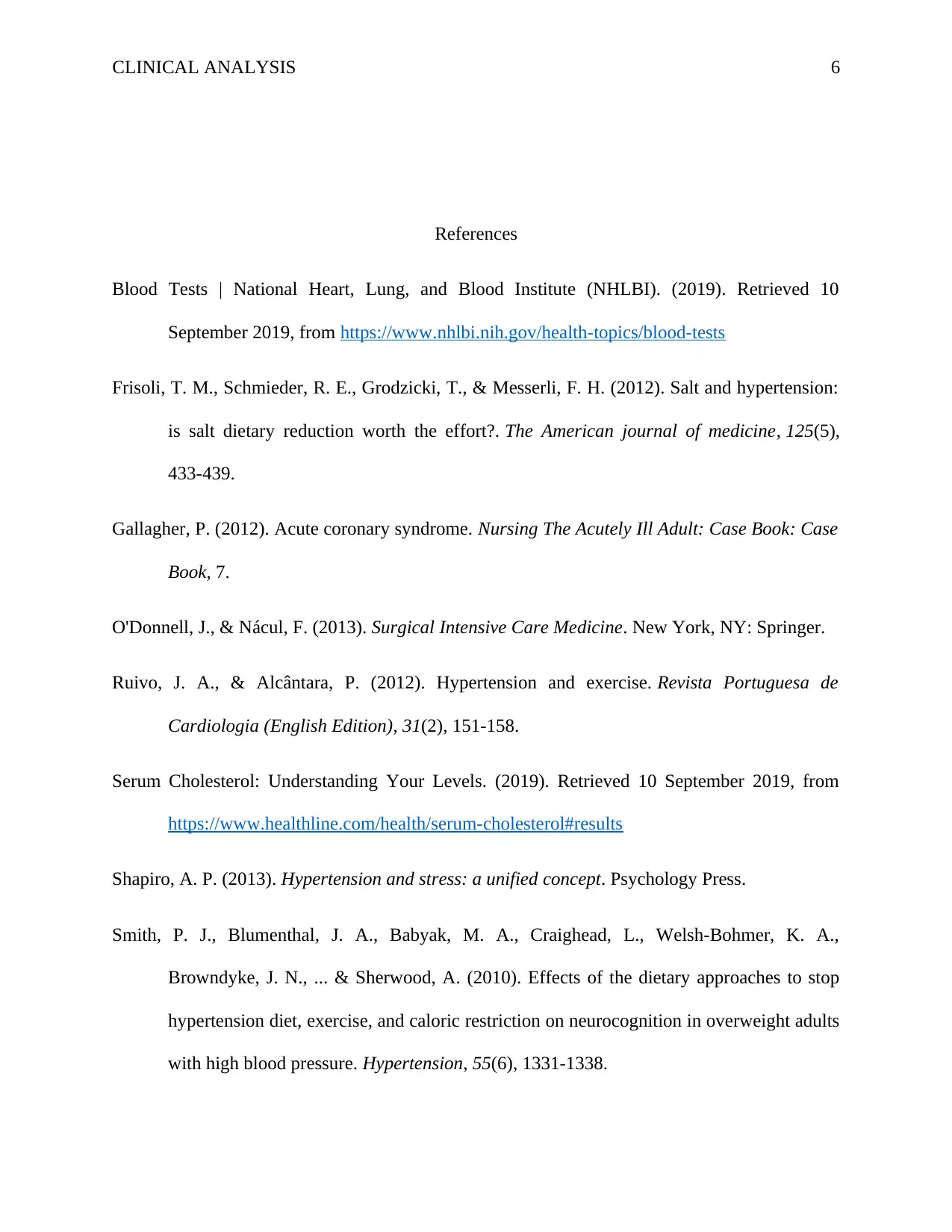
CLINICAL ANALYSIS 6
References
Blood Tests | National Heart, Lung, and Blood Institute (NHLBI). (2019). Retrieved 10
September 2019, from https://www.nhlbi.nih.gov/health-topics/blood-tests
Frisoli, T. M., Schmieder, R. E., Grodzicki, T., & Messerli, F. H. (2012). Salt and hypertension:
is salt dietary reduction worth the effort?. The American journal of medicine, 125(5),
433-439.
Gallagher, P. (2012). Acute coronary syndrome. Nursing The Acutely Ill Adult: Case Book: Case
Book, 7.
O'Donnell, J., & Nácul, F. (2013). Surgical Intensive Care Medicine. New York, NY: Springer.
Ruivo, J. A., & Alcântara, P. (2012). Hypertension and exercise. Revista Portuguesa de
Cardiologia (English Edition), 31(2), 151-158.
Serum Cholesterol: Understanding Your Levels. (2019). Retrieved 10 September 2019, from
https://www.healthline.com/health/serum-cholesterol#results
Shapiro, A. P. (2013). Hypertension and stress: a unified concept. Psychology Press.
Smith, P. J., Blumenthal, J. A., Babyak, M. A., Craighead, L., Welsh-Bohmer, K. A.,
Browndyke, J. N., ... & Sherwood, A. (2010). Effects of the dietary approaches to stop
hypertension diet, exercise, and caloric restriction on neurocognition in overweight adults
with high blood pressure. Hypertension, 55(6), 1331-1338.
References
Blood Tests | National Heart, Lung, and Blood Institute (NHLBI). (2019). Retrieved 10
September 2019, from https://www.nhlbi.nih.gov/health-topics/blood-tests
Frisoli, T. M., Schmieder, R. E., Grodzicki, T., & Messerli, F. H. (2012). Salt and hypertension:
is salt dietary reduction worth the effort?. The American journal of medicine, 125(5),
433-439.
Gallagher, P. (2012). Acute coronary syndrome. Nursing The Acutely Ill Adult: Case Book: Case
Book, 7.
O'Donnell, J., & Nácul, F. (2013). Surgical Intensive Care Medicine. New York, NY: Springer.
Ruivo, J. A., & Alcântara, P. (2012). Hypertension and exercise. Revista Portuguesa de
Cardiologia (English Edition), 31(2), 151-158.
Serum Cholesterol: Understanding Your Levels. (2019). Retrieved 10 September 2019, from
https://www.healthline.com/health/serum-cholesterol#results
Shapiro, A. P. (2013). Hypertension and stress: a unified concept. Psychology Press.
Smith, P. J., Blumenthal, J. A., Babyak, M. A., Craighead, L., Welsh-Bohmer, K. A.,
Browndyke, J. N., ... & Sherwood, A. (2010). Effects of the dietary approaches to stop
hypertension diet, exercise, and caloric restriction on neurocognition in overweight adults
with high blood pressure. Hypertension, 55(6), 1331-1338.
⊘ This is a preview!⊘
Do you want full access?
Subscribe today to unlock all pages.

Trusted by 1+ million students worldwide
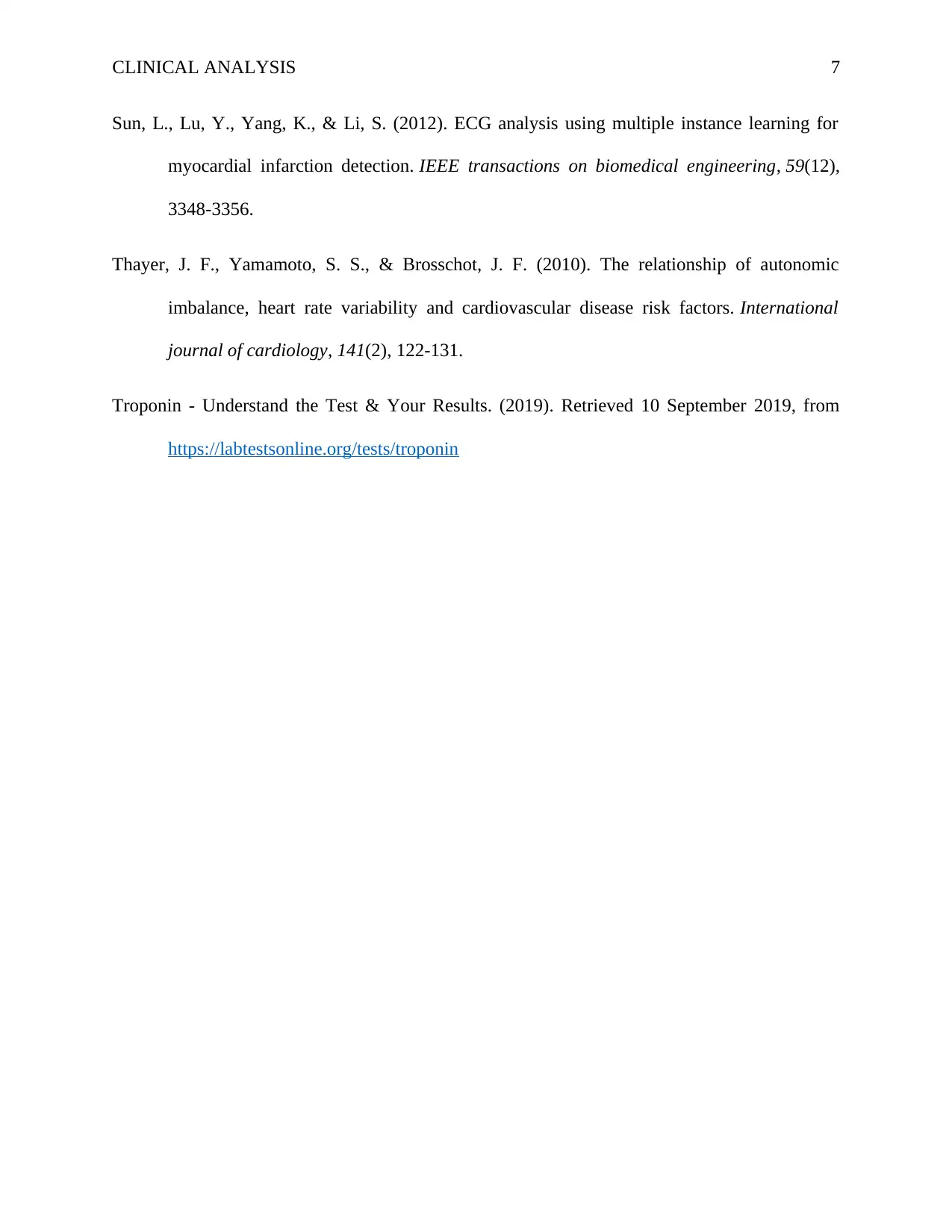
CLINICAL ANALYSIS 7
Sun, L., Lu, Y., Yang, K., & Li, S. (2012). ECG analysis using multiple instance learning for
myocardial infarction detection. IEEE transactions on biomedical engineering, 59(12),
3348-3356.
Thayer, J. F., Yamamoto, S. S., & Brosschot, J. F. (2010). The relationship of autonomic
imbalance, heart rate variability and cardiovascular disease risk factors. International
journal of cardiology, 141(2), 122-131.
Troponin - Understand the Test & Your Results. (2019). Retrieved 10 September 2019, from
https://labtestsonline.org/tests/troponin
Sun, L., Lu, Y., Yang, K., & Li, S. (2012). ECG analysis using multiple instance learning for
myocardial infarction detection. IEEE transactions on biomedical engineering, 59(12),
3348-3356.
Thayer, J. F., Yamamoto, S. S., & Brosschot, J. F. (2010). The relationship of autonomic
imbalance, heart rate variability and cardiovascular disease risk factors. International
journal of cardiology, 141(2), 122-131.
Troponin - Understand the Test & Your Results. (2019). Retrieved 10 September 2019, from
https://labtestsonline.org/tests/troponin
1 out of 7
Related Documents
Your All-in-One AI-Powered Toolkit for Academic Success.
+13062052269
info@desklib.com
Available 24*7 on WhatsApp / Email
![[object Object]](/_next/static/media/star-bottom.7253800d.svg)
Unlock your academic potential
Copyright © 2020–2025 A2Z Services. All Rights Reserved. Developed and managed by ZUCOL.





